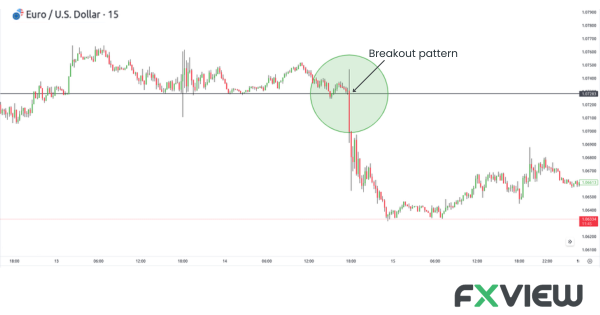
Breakout in Trading- A Beginner’s Guide!
In the roller-coaster world of Forex trading, traders constantly search for strategies to give them the edge. Today, we’ll plunge into one popular strategy – the breakout in trading. For the uninitiated, the term may sound like something from an action movie. But in the world of Forex, it’s just another day at the office.

What is a Breakout in Trading Strategy?
A breakout in trading strategy is when you speculate on the ‘break’ of a crucial level in the price action. It’s like a surfer catching the perfect wave – the one that breaks away from the rest. This strategy works on the basic principle that once a significant price level breaks, a strong movement may follow in the direction of the break.
Imagine a ball ricocheting in a small box, suddenly finding a small hole, and escaping out to roll freely. That’s essentially the breakout in trading strategy. It is based on the premise that once the price surpasses certain defined resistance or support levels (the box in our analogy), it tends to keep moving in that direction (up for resistance, down for support), potentially leading to a strong price movement (the free-rolling ball).
Types of Breakouts in Trading
Identifying the types of breakouts in trading is crucial. Primarily, there are two types:
- Continuation Breakout
- Reversal Breakout
The continuation breakout happens during an ongoing trend. Think of it as a marathon runner catching their breath before pushing on to the Finish Line. Similarly, in trading, it represents a brief pause before the price resumes in the direction of the existing trend.
On the other hand, a reversal breakout is akin to the plot twist in a thrilling novel. It may occur when the price breaks the trend line, suggesting a possible trend reversal. It’s an unexpected yet exciting scenario that keeps traders on their toes!
Can Breakout Trading be profitable?
Breakout in trading may be profitable, keeping market volatility and timing in mind. But like any strategy, it doesn’t guarantee any profits and there is always high risk of losing the invested capital.
Pros and Cons of Breakout Trading
Breakout in trading, like a coin, has two sides to it. On the upside, it may offer potential returns and can work in both potential bullish and bearish markets.
However, one significant disadvantage is the risk of false breakouts, which can lead to potential losses. Additionally, breakout trading requires constant monitoring of the market, making it time-consuming.
Can Breakout Trading work?
Does breakout in trading work? It could work, yet, it’s essential to remember that breakout trading, like any other strategy, could lead to losses and requires practice, skill, and a pinch of luck. It’s not a magic wand, but a tool in a trader’s toolbox.
Tips for Trading Breakouts
As we navigate toward the end, here are some nifty tips for trading breakouts:
- Patience is a virtue: Hold off until you have an indication before entering a trade.
- Set Profit Targets: Keep realistic targets for potential profits
- Stop-loss orders may be helpful: They may help to manage your risk by setting a limit to your potential losses.
- Stay informed: Keep track of economic news and global events affecting currency prices.
Conclusion
Breakout in trading strategy can be an option for trading style if used with the correct approach. Combining breakout trading strategies with Fibonacci Trading can provide a comprehensive approach to trading. However, it requires a deep understanding, sharp vigilance, and unyielding patience. So, are you ready to embrace the break and take the plunge into the vast ocean of Forex trading? The breakout wave is awaiting your ride!
Disclaimer: The information contained in this article is provided for educational and informational purposes only and it is not intended to be, nor does it constitute financial, investment or trading advice. You should not make any financial, investment or trading decision based on the information provided in this article without performing your own research or seeking advice from an independent advisor.



